
Updated on: October 23, 2025
- 🥇 1Password : Includes high-level encryption, secure password and data sharing, dark web monitoring, multi-factor authentication options, an intuitive admin dashboard, and more. It’s also easy to integrate into your company, making it great for businesses of all sizes.
Managing passwords is central to security, but many businesses struggle with it. I explored dozens of password managers for businesses in 2025, and I was surprised by how many fell short — they were either too complex, too expensive, or offered little more than a glorified spreadsheet.
After extensive testing, I found 9 password managers that strike the perfect balance between security and usability. They all have standard password management and business-specific features like Single Sign-On (SSO) and directory integration.
Whether managing a small team or thousands of employees, you’ll discover tools to secure your data and simplify password management. My favorite business password manager is 1Password, but any on my list will easily increase your company’s password security. Note, most business password managers use bespoke pricing models, meaning you’ll need to talk to sales to get solid numbers.
Quick Summary of the Best Business Password Managers in 2025
May 2025 update: We’ve revised this article to reflect the current state of the password managers covered. Most notably, Dashlane introduced a new enterprise plan, and 1Password has added new location-linked features.
🥇1. 1Password — Best Password Manager for Businesses of All Sizes in 2025
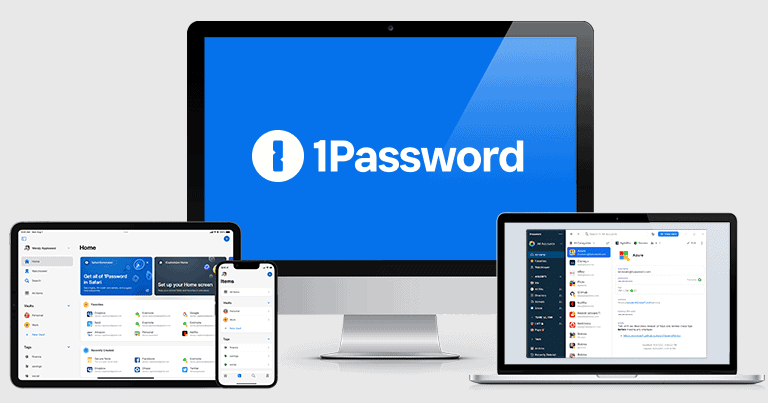
1Password is easy to use and has more enterprise-oriented features than any option on this list. In addition to standard features like advanced two-factor authentication (2FA), secure password sharing, and dark web monitoring, business subscribers also get SSO, admin tools, and several useful integrations.
- Location-based access options
- Loads of developer integrations
- Several SSO options
- Flexible permissions
- Relatively expensive
I love how 1Password lets you connect third-party apps to add new users and manage their accounts. For example, after connecting my team’s Slack account to 1Password, I invited everyone to 1Password via Slack and could monitor their log in status. I could also get Slack notifications when someone needed their 1Password account recovered.
Setting up 1Password is easy, too, with comprehensive online guides and video tutorials. The resources are clear and detailed, covering everything from initial installation to advanced features and best practices. Large firms opting for the top plan will benefit from dedicated onboarding support. You’ll also get reports on how well your team is adopting good password management habits.
Among other features, 1Password includes:
- Admin control panel.
- Password vaults.
- Advanced 2FA options.
- Passkey support.
- Customizable security settings.
- Active directory integration.
- SSO options (Okta, Duo, OneLogin, and more).
- Developer integrations.
- Dark web monitoring.
- Secure storage (5 GB per user).
- Location-based passwords.
- Hidden vaults (Travel Mode).
- SIEM integration.
I’m a big fan of 1Password’s password vaults — you can organize specific passwords into vaults and only allow specific team members access to them. For example, I created a vault for my marketing team that only they could access.
Setting up 2FA is very easy. 1Password is compatible with a range of 2FA methods, including authenticator apps (like Google Authenticator), hardware security keys, and enterprise solutions like Duo. Admins can make it so all users have to use 2FA, which is worth considering.
The developer features also make 1Password stand out from the competition. It can interact with AWS and has great CI/CD integrations, so it’s a good way to manage secrets. I saw more integrations with popular tools than I did with any other password manager. Integrations with Datadog’s SIEM tool make it easy to get a quick picture of company-wide security.
1Password also has unique location-based tools that no other password manager provides. For one, Travel Mode allows you to restrict access to vaults based on which country the user is in, reducing risks associated with international travel. Additionally, you can configure logins or other data to automatically appear at the top of a user’s vault based on their location — a feature with a wide range of enterprise applications.
What I like the most about 1Password is that all this wealth of features doesn’t make it complicated to use — on the contrary, it’s the most user-friendly option on this list, and that matters because the single biggest challenge you’ll face when introducing a password manager into your business is getting your employees to actually use it.
1Password offers 3 business plans. At $19.95 / month, Teams Starter Pack is an affordable option that covers 10 users and comes with useful developer tools, but it’s missing advanced options like SSO or AD integration. 1Password Business includes all of the mentioned features as well as 5 GB of encrypted cloud storage per user, 20 guest access accounts, and a Families plan for every user (1Password’s family plan is our top-rated password manager for families in 2025). The Enterprise adds onboarding and training assistance, and a dedicated account manager (contact sales for pricing).
Bottom Line:
1Password offers excellent security and a wider range of enterprise features than any competitor. It’s also secure and very easy to set up. I particularly like 1Password’s third-party integration options, intuitive admin controls, and separate vaults for secure password sharing. 1Password has 3 affordable business plans and offers free trials (usually for 14 days, but extended trials are possible).
Read the full 1Password review >
🥈2. Dashlane — Advanced Security Features + Very Easy to Use
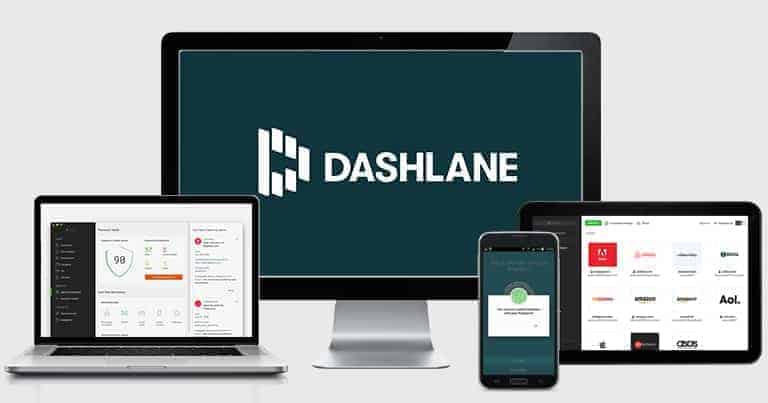
Dashlane has everything businesses need to manage their passwords — including 256-bit AES encryption, a wide range of features, an intuitive employee dashboard, secure account recovery options, and a well-built and easy-to-use admin console.
- Integrated VPN
- Streamlined onboarding
- Advanced phishing defenses
- Secure secrets management
- Limited organizational flexibility
- Relatively few 2FA options
Integrating Dashlane into a company’s systems is easy thanks to great design and a wealth of resources. The admin console makes managing permissions and requirements on employee accounts simple.
There are comprehensive setup guides and a robust resource library, which are detailed and easy to follow. While the resource library is extensive, it offers fewer video tutorials than 1Password. However, the available guides cover everything from initial installation to more advanced features. Additionally, Dashlane offers a dedicated admin support center and a specialist onboarding team for Omnix customers.
Dashlane’s business plans include:
- Two-factor authentication (2FA).
- Dark web monitoring.
- SSO options.
- Passkey support.
- Multiple account recovery options.
- Advanced anti-phishing protections.
- Secure password sharing.
- VPN (virtual private network).
- Active directory integration.
- Advanced security reports.
- Remote account deletion.
- Secrets management.
I’m a big fan of Dashlane’s monitoring features, which alert teams to phishing attempts and breaches. It alerts you to sites imitating Dashlane and will even issue a warning if you’re about to enter a saved password on a website other than the one it’s associated with.
I also really like Dashlane’s security dashboard, which shows your team’s overall password security score. The security dashboard has a chart that helps you visualize your team’s overall security month-to-month, and it also alerts you if a team member’s passwords are weak, reused, or compromised. If you opt for an Omnix plan, you can view risk insight reports and benefit from AI-powered anti-phishing protections. Similarly, integrations for SIEM tools like Splunk mean admins can view reports and logs about other information environments.
The Secrets feature is an encrypted vault for storing and sharing “secrets” like API keys, access tokens, database passwords, and private certificates. Its user-friendly interface makes it easy to store, access, and share secrets with team members while managing permissions effectively.
Dashlane has 3 business plans. Dashlane Standard ($20.00 / month) covers up to 10 users but doesn’t include the VPN, advanced phishing protections, or SSO options. The Business plan offers a more comprehensive set of features, including SIEM integrations, SSO, and advanced enforcement policies and monitoring tools. Omnix, Dashlane’s most comprehensive plan, adds several tools and services that offer proactive protection against social engineering attacks (contact sales for pricing).
Bottom Line:
Dashlane has advanced security features and is one of the most intuitive business options on the market. It makes the usually complex IT integration process seem easy. For end users, deploying credentials and following policies is simple. On the management side, Dashlane is easy to integrate despite its many advanced features. Dashlane is a bit more expensive than other brands, but its ease of use and extra features make it worth the price. Free trials and demos are available.
Read the full Dashlane review >
🥉3. Proton Pass — Secure, Privacy-Centered Enterprise Password Solution
Proton Pass stands out for its uncompromising focus on privacy and security, built on end-to-end encryption and open-source code. As part of the Proton ecosystem, it provides robust enterprise tools like admin controls, secure sharing vaults, and compliance features, making it ideal for teams handling sensitive data. Business users get excellent integration with other Proton services, plus unique privacy extras like unlimited email aliases to prevent breaches.
In my tests, Proton Pass handled enterprise workflows well. Vault sharing made it simple to separate team accounts (like shared SaaS logins) from individual ones, and email aliasing proved invaluable for controlling exposure when signing up for third-party services. If an alias gets compromised, it can be disabled immediately without affecting core business accounts — a big plus for reducing phishing risks.
- Strong Swiss privacy laws
- Excellent email aliasing tools
- Generous encrypted storage
- Advanced account protection (Sentinel)
- Limited support options
- Fewer advanced policy controls
- Fewer 3rd-party integrations
Among other features, Proton Pass includes:
- Admin console for user provisioning and policy enforcement.
- Multiple vaults for organized sharing.
- Built-in 2FA with TOTP generation.
- Passkey support.
- Dark web and breach monitoring (Pass Monitor).
- SSO and SCIM integration (Professional plan).
- Activity logs and usage reports.
- Encrypted notes and credit card storage.
- Emergency access for trusted contacts.
- Integration with Proton Mail, Drive, Calendar, and VPN.
I’m a fan of the unlimited hide-my-email aliases, which help mask real emails during sign-ups to reduce spam and breach risks — a feature not commonly found in other managers. The password generator offers both random and memorable options, and enforcement policies let admins require strong passwords organization-wide. While it lacks some advanced developer integrations compared to 1Password, its ecosystem ties make it a great all-in-one for privacy-centric businesses.
Enterprises also benefit from Proton Sentinel, an AI-driven protection system that detects suspicious login activity and blocks unauthorized access. This goes beyond standard 2FA and adds meaningful extra security for accounts holding critical company data.
Proton Pass has 2 main business plans (minimum 3 users). Pass Essentials starts at $1.99 / month and includes unlimited passwords, vaults, enforced 2FA, Proton Sentinel, and email aliases, but misses SSO. Pass Professional at $4.49 / month adds SSO/SCIM, customizable team policies, Pass Monitor reporting, and detailed logs. Custom Enterprise options are available by contacting sales. You can test the business plans out with a 14-day trial, and all plans are backed by a 30-day money-back guarantee.
Alternatively, businesses can get Proton Pass through the Proton Business Suite, which bundles Pass Professional with Proton Mail Professional, Proton Drive, and Proton VPN. This makes it easy to manage communication, file storage, and credential security under one unified, privacy-first platform.
Bottom Line:
Proton Pass delivers exceptional privacy and security with end-to-end encryption, open-source transparency, and business-friendly tools like admin controls and secure vaults. It’s especially suited for enterprises prioritizing compliance and data sovereignty, though support is more limited than rivals. Affordable plans and strong features make it a top pick, with 14-day free trials available to test it out.
Read the full Proton Pass review >
4. RoboForm — Great Security With Excellent Auto-Fill Capabilities
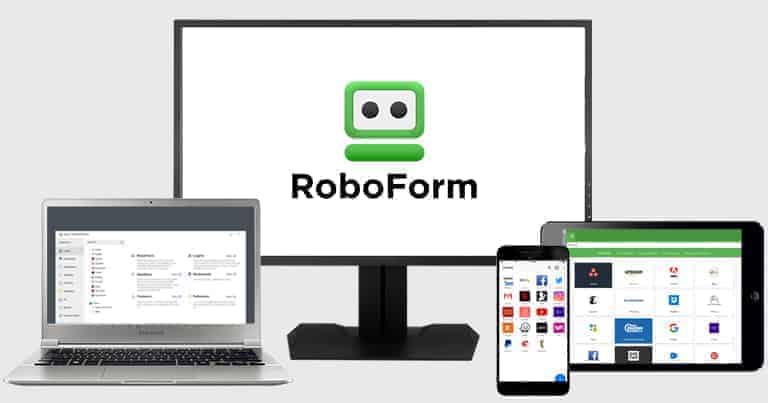
RoboForm has the best auto-fill capabilities of any business password manager. I tested it with many different web forms — legal forms, HR forms, and procurement request forms — and RoboForm auto-filled all of them with no mistakes. Even top brands like Dashlane and 1Password can’t really handle complex forms, but RoboForm does this with ease.
- Advanced form-filling tool
- Local hosting option
- Flexible access controls
- Few importation options
- Little help resources
RoboForm offers various setup resources, including clear online guides and a helpful playlist of video tutorials. These resources cover essential setup steps and basic usage, making them accessible to most users. The resource library isn’t quite as extensive as 1Password’s. However, RoboForm’s guides are still comprehensive enough to facilitate a smooth setup process.
RoboForm also has a range of other features, including:
- AD integration.
- Admin controls.
- SSO options.
- Advanced reporting.
- Additional 2FA options.
- Passkey support.
- Secure sharing.
I really like RoboForm’s user access tools. Basically, you can create different shared vaults for different departments. Further customization options allow you to enable access to certain shared vaults only when connected to specific networks. This ensures that employees don’t accidentally compromise logins outside the company offices.
RoboForm Business supports Single Sign-On (SSO) via external identity providers such as Azure / MS Entra ID, Okta, and Ping One. This also allows the company admin complete control of all company data. The admin can determine a user’s permissions within a group. If the user’s access is set as “Limited”, they won’t be able to view or edit any shared logins. They’ll be able to use RoboForm for website login purposes only, and they won’t have access to the actual passwords.
You can’t manually add passwords in the desktop app or admin dashboard, which is annoying. I had to install the RoboForm browser extension and then log into my accounts so they could be auto-saved. I also don’t like that you have to use the browser extension to import passwords — competitors like NordPass allow users to import passwords using the desktop app. However, these issues won’t be a big problem for most business users.
Though it doesn’t have as many developer and enterprise-oriented features, RoboForm is much cheaper than most other brands on this list. The RoboForm Business plan cost per user is lower than other brands on this list, and it offers discounts for more users and longer-term subscriptions. There is also the Enterprise plan, which comes with more comprehensive onboarding support and a local hosting option.
Bottom Line:
RoboForm’s auto-fill capabilities are the best on the market, accurately filling out even the most complex web forms. RoboForm also includes a decent range of business features, including integration options and secure password sharing. However, it isn’t as intuitive as some other password managers, so it may not be the best option for non-technical users. If you’re interested, you can try RoboForm using a 14-day free trial.
Read the full RoboForm review >
5. NordPass — Good Security & Sharing Options
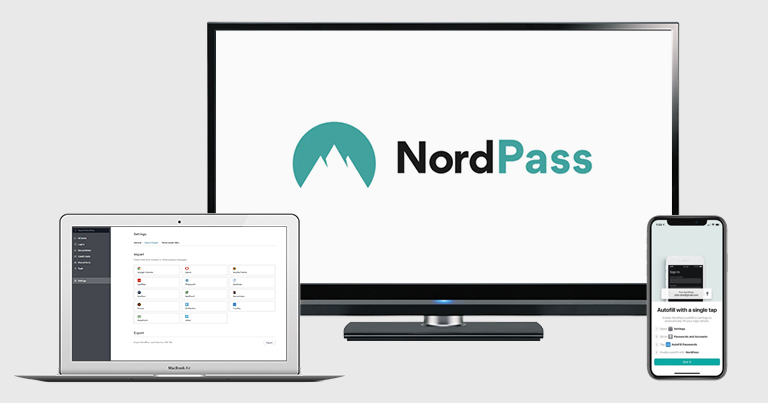
NordPass is an intuitive password manager that uses xChaCha20 encryption — this encryption method isn’t necessarily more secure than 256-bit AES encryption (which all of the other brands on this list use), but it’s more modern.
- Email masking
- Domain-level breach monitoring
- Authenticator app
- Relatively weak auditing
- Restrictive mid-level plan
It offers a streamlined setup process — with setup guides and tutorials available on its website that are clear and detailed, providing step-by-step instructions for both basic and advanced features. Additionally, NordPass offers face-to-face onboarding for Enterprise users.
Additional features include:
- Password sharing.
- Trusted contacts.
- Shared folders (Enterprise only).
- Admin panel/security dashboard.
- Advanced MFA options.
- Passkey support.
- SSO integrations.
- Developer integrations.
- Breached accounts scan.
- Email masking.
- Coverage for up to 250 users (Business) or unlimited users (Enterprise).
I really like the shared folder feature. NordPass lets you save passwords, personal information, credit card details, secure notes, and more into folders. You can then share those folders with trusted team members. It’s fairly straightforward, but 1Password comes with better organizational tools.
I also like the extended functionality the data breach scanner provides business users. When using a personal plan, NordPass’s data breach scanner monitors individual emails, but with the business plan, you can monitor your entire domain, which is really cool. All breaches are visible from the admin dashboard.
On a related note, the email masking feature is great for businesses. It allows employees to hide their real email address behind a mask. Messages sent to these email masks are forwarded to the primary email without revealing the actual address. Admins can control the use of the feature organization-wide, disabling it or making it the default when employees create new accounts. This reduces spam, exposure, and can potentially strengthen your company’s resistance to social engineering attacks.
There’s also a convenient MFA option for business users — the NordPass Authenticator app. This sidesteps the need for SMS verification or an external authenticator app, instead allowing employees to unlock a TOTP within the NordPass app using biometrics. NordPass also supports third-party authenticator apps like Authy as well as USB keys. I’m also happy to see that, like Dashlane, NordPass has integrated passkeys into its desktop app and Web Vault.
NordPass offers 3 affordable business plans: NordPass Teams, Business, and Enterprise. Teams covers 10 users for $1.79 / month per person, but it doesn’t have much in the way of enterprise features beyond SSO. Business adds the security dashboard, shared folders, and Vanta integration. Larger firms and those looking for NordPass’s business features can opt for Enterprise to get additional SSO options, provisioning, and more. The business plans are available as 14-day free trials and are backed by a 30-day money-back guarantee.
Bottom Line:
NordPass offers advanced encryption and streamlined password sharing. While it isn’t as feature-rich as other products on my list, I really like how intuitive NordPass is. You can try the business plans for free for 14 days.
Read the full NordPass review >
6. Keeper — Best for Secure Communication Between Team Members
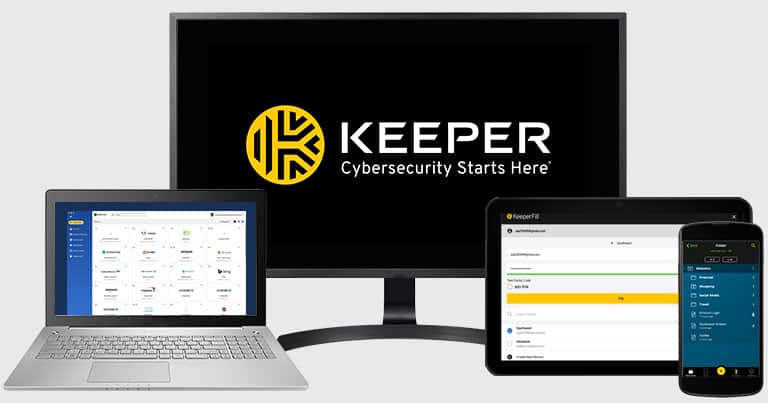
Keeper is a very intuitive and secure password manager with many advanced integrations and admin customization options. For an extra fee, you can add Keeper’s encrypted messenger and file-sharing app, KeeperChat. It lets you securely share important files and even set self-destruct timers on messages containing sensitive information.
- Secure messaging app
- Advanced developer integrations
- Privileged access management
- Breach monitoring is an add-on
- Less intuitive for admins
Like 1Password, Keeper provides detailed online guides and video tutorials that cover everything from basic setup to advanced features. The resources are clear and easy to follow, making them accessible to users of all technical levels. Additionally, Keeper offers comprehensive training support, including admin training sessions.
Keeper also offers a wide range of features, including:
- Advanced security policies.
- Many 2FA options.
- Passkey support.
- Password rotation.
- Admin dashboard.
- Developer integrations.
- SSO integrations (Azure, Okta, Microsoft ADFS, Google Workspace, and more).
- Dark web monitoring (add-on).
I really like that admins can enforce very specific security policies, like requiring 20+ character master passwords or biometric 2FA. You can also enforce and even automate regular password rotation, which is fairly unique. However, like many of Keeper’s great business features, it’s a paid add-on on all but the most expensive plan. The advanced options are nice, but I found Keeper’s admin panel to be harder to use than others.
On that note, BreachWatch (another add-on) is also really good. It provides dark web monitoring, alerting employees if one of their accounts has been compromised in a data breach. It works well, but I wish that Keeper included dark web monitoring as a default feature (like Dashlane does).
Keeper has 4 business plans. The Business Starter plan costs $7.00 / month and covers up to 10 people and comes with a free Family plan for each user, but it’s missing some of the admin and developer tools. The Business plan basically just adds SCIM provisioning, while Enterprise adds various developer and admin integrations. Finally, Privileged Access Manager adds a lot of features that are otherwise only available as add-ons (though it’s still missing BreachWatch and KeeperChat)
Bottom Line:
Keeper is intuitive, well-designed, and has excellent business-oriented features (though a lot are paid add-ons, unfortunately). I really like KeeperChat and how it makes communication and file sharing between team members convenient and secure. All plans are available as 14-day free trials.
7. Password Boss — Intuitive & Easy to Set Up
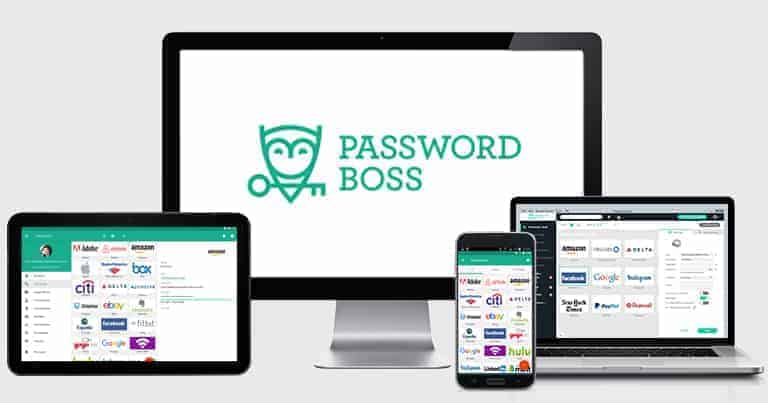
Password Boss is an intuitive password manager with an easy-to-use admin dashboard and a good range of features. When I tested Password Boss, I found it easy to manage customization options and onboard new team members. I had no issue connecting Microsoft Active Directory and Azure. However, Password Boss doesn’t support as many AD and SSO integrations as 1Password, missing even popular tools like Okta.
- Personal vault for all users
- Anti-theft protection
- Insightful reports
- Lack of SSO integrations
- Few developer tools
- Relatively expensive
I like how there are detailed online guides and tutorials that cover basic and advanced features, which are all easy to follow. Additionally, Password Boss offers priority support with onboarding.
Password Boss also offers:
- Password sharing.
- Detailed activity reports.
- Anti-theft protection.
- Breached accounts scan.
I found the offboarding process pleasingly simple. I was able to change the settings to automatically remove all business passwords from a user’s account when offboarding them. This is something even top business password managers don’t offer.
Password Boss’s anti-theft protections also work really well — they let you remotely wipe the data stored on a lost or stolen device, ensuring that none of your business data falls into the hands of bad actors.
Password Boss’s business plans start at a relatively low cost per user, which gets even lower if you opt for a longer subscription. Password Boss For Business is more for smaller teams. Password Boss For MSPs is better for bigger enterprises, as it offers detailed activity reports, AD connections, and advanced security policy settings.
Bottom Line:
Password Boss is very simple to set up and use, and it offers a good range of features. The onboarding and offboarding processes are easy to follow, and I particularly like the range of security policy settings. While the top competitors on this list offer a few more features, I still think Password Boss is a well-rounded business password manager. Both of Password Boss’s business plans are available as a 14-day free trial.
Read the full Password Boss review >
8. Bitwarden — Best Open-Source Password Manager for Business

Bitwarden is a highly secure, open-source password manager that caters to businesses of all sizes. As an open-source platform, Bitwarden allows anyone to audit its code, which is not all that common among password managers for businesses.
- Local hosting option
- Free family plans
- Open source
- Rather clunky UI
- Few developer tools
- Imperfect auto-save
Bitwarden provides robust security features such as advanced two-factor authentication (2FA), secure password sharing, and customizable user roles. It’s also one of the more affordable options on this list.
Other features include:
- Advanced 2FA (hardware keys, authenticator apps, and Duo).
- SSO (compatible with SAML 2.0 providers like Okta and Azure AD).
- Directory integration.
- Self-hosting.
- Account recovery.
- Shared vaults.
- Integrated TOTP authenticator.
- Encrypted file sharing.
One of Bitwarden’s best features is its flexible deployment. Businesses can choose between cloud hosting or self-hosting on their own servers. Having this option is great, especially for organizations with strict compliance or data sovereignty requirements, but for a majority of small businesses, cloud hosting is a safer option.
During testing, I found the setup process straightforward, with clear documentation and resources guiding me through cloud and self-hosted configurations.
While it doesn’t offer as many developer tools as Dashlane, Bitwarden does include API access. As a result, you can gain all kinds of insights into how your organization uses Bitwarden. You can host the API locally, too, which is nice.
Bitwarden also offers a comprehensive security dashboard, which provides insights into the overall health of stored passwords. While I didn’t find it as intuitive to use as 1Password’s, it’s still neatly organized. Admins can monitor weak or reused passwords across the organization and prompt employees to update them as needed.
Bitwarden offers 2 business plans: Teams and Enterprise. Teams is fairly generous in terms of features, but it doesn’t allow you to set organizational policies. To get that ability (plus the self-hosting option, a family plan for every user, and more), you’ll need Enterprise. Bitwarden offers a free trial (though it’s just one week long) and backs business plans up with a 30-day money-back guarantee.
Bottom Line:
Bitwarden is an excellent choice for businesses seeking a secure, open-source password manager with flexible deployment options. While it may not have some of the advanced integrations or polished UI of competitors like 1Password or Dashlane, it’s well-designed and feature-rich enough to make it a valuable option. You can try Bitwarden’s business plans with a 7-day free trial to see if it’s the right fit for your organization, or make use of the 30-day money-back guarantee.
Read the full Bitwarden review
9. Sticky Password — Decent, Cost-Effective Option
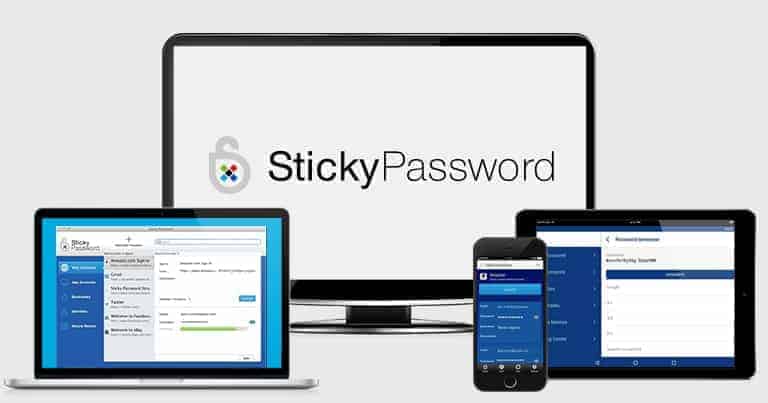
Sticky Password is an okay option for smaller teams looking for a simple business password manager. The interface is a little outdated and not nearly as well-designed as other brands on this list. The admin controls are quite limited, but it’s still a secure option that can do the job if you’re keen on a self-hosted enterprise password manager.
- Local or Wi-Fi sync
- Portable version
- Dark web monitoring
- Expensive
- Outdated UI
- No file storage
Sticky Password is pretty easy to set up, both for admins and end users. It doesn’t offer any of the onboarding support that 1Password and Dashlane do. There is a YouTube channel, but like most of Sticky Password’s support resources, it’s clearly not aimed at enterprise customers. Still, given the software’s simplicity, this isn’t too much of an issue.
Compared to competitors, Sticky Password doesn’t have many features tailored to businesses. That said, it does the basics well and has some good features. These include:
- Password sharing.
- 2FA options.
- Dark web monitoring.
- Customizable permissions.
- Portable USB password vault option.
I like Sticky Password’s portable USB option, which lets admins access their passwords on any employee’s Windows PC by inserting their external drive and launching the USB version of Sticky Password, named “Portable Passwords.” Additionally, users can securely access their vaults from any device using the Contactless Connect feature on Sticky Password’s website.
Sticky Password Teams isn’t as advanced as competitors like 1Password. But at $2.50 / month, it’s a decent low-cost option for small businesses. There’s also a nice bonus for eco-conscious users — a portion of the proceeds from each license sold is donated to a charity protecting endangered manatees in Florida. Sticky Password offers 30-day trials as well as a 30-day money-back guarantee.
Bottom Line:
Sticky Password offers high-level security at a reasonable price. Most users will also find Sticky Password easy to use. Honestly, it’s not my favorite password manager on this list, mainly because of its somewhat outdated interface and lack of features for firms. You can try it for free for 30 days, and there’s also a 30-day money-back guarantee on the Teams plan.
Read the full Sticky Password review >
Bonus. Enpass — Affordable Password Manager With Basic Integrations
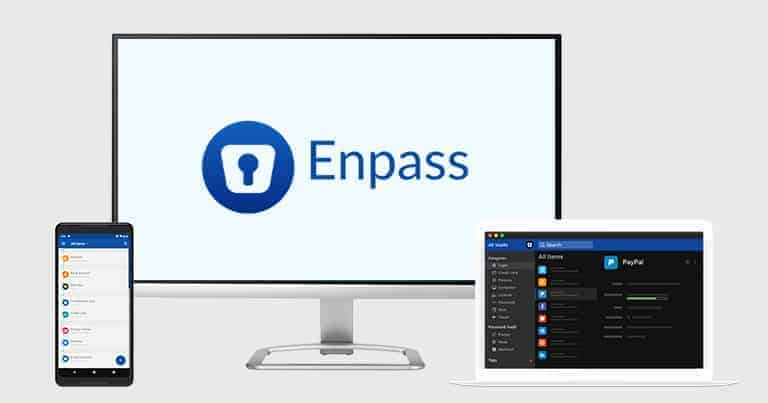
Enpass is a solid password manager with a few business-oriented features. Like the other options on this list, it protects passwords and other types of sensitive information with top-notch encryption. Though the consumer version is fully offline, Enpass’s enterprise products can be synced over the cloud using a service or server of your choice.
- Desktop app
- Account recovery
- Keyfile support
- No developer tools
- Few SSO options
- Outdated UI
The most unique aspect of Enpass is probably the inclusion of keyfiles as a central feature. These are files that need to be present in order to access your vault. You’ll still need a master password (and potentially a TOTP if you’ve set up additional forms of 2FA), so keyfiles enhance security. I like that admins can set policies, including making keyfiles mandatory.
Enpass has all of the basics I expect in a password manager, including:
- Password sharing.
- Auto-save/auto-fill.
- Account recovery.
- 2FA.
- Breach monitoring.
- Vault auditing
- Customizable permissions.
While it doesn’t offer anything comparable to the developer tools included with 1Password’s top-tier plan, Enpass includes several business-focused features. These range from standard tools like SSO, an admin console, password sharing, and SIEM integration. All plans also support Microsoft 365 and Google integrations, though Enpass isn’t quite as widely compatible across platforms as Dashlane is. That said, it’s great to see that Enpass has built automatic data deletion into the offboarding process.
I like that Enpass has a desktop app and browser extensions (most competitors only have the latter), but it’s far from the most well-designed tool I’ve used. Password sharing is very unintuitive, for example. On the other hand, the mobile app is much better. Every feature is exactly where you’d expect it to be.
Enterprise customers signing up for Enpass have a few options when it comes to subscriptions. The more basic option is the Standard Plan ($2.99 / month). It gets you the admin console and enforcement tools, but is missing SSO and most integrations. The Starter Plan comes with the same features but comes as a set package with licenses for $9.99 / month. To get the full version, you’ll have to contact sales and ask about the Enterprise Plan. All plans are available as 14-day free trials and are backed by 30-day money-back guarantees.
Bottom Line:
Enpass is a secure password manager geared towards businesses. The inclusion of keyfiles adds more flexibility when it comes to 2FA, but I wish it supported advanced methods like YubiKeys. It doesn’t have as many integrations as some of the other options on this list, but all of the basic features work well enough.
Quick Comparison Table
Testing Methodology: Comparison & Ranking Criteria
I used our comprehensive testing methodology to determine the best password managers for businesses in 2025. In short, my focus was on security, ease of use, administrative controls, and inclusion of enterprise-specific features, like integrations and developer tools. Here are some of the things I considered:
- I looked into security. It’s crucial that a business password manager has advanced security tools like two-factor authentication (2FA) and robust encryption (preferably 256-bit AES or higher). Zero-knowledge protocols are also essential for maintaining privacy and security. All the products on my list deliver top-notch security.

- I evaluated the ease of setup and onboarding. A business password manager should be straightforward to use, from onboarding all the way to daily use. Every option on this list is easy to use, even for non-technical employees. Some, like Dashlane, have in-house employees dedicated to assisting with onboarding.
- I assessed the admin controls. Effective admin controls allow companies to ensure that employees use best practices when managing secrets. All the brands on this list offer some form of admin controls, enabling IT departments and administrative staff to restrict permissions and enforce security protocols as needed.
- I evaluated customer support. Effective customer support is crucial for businesses, especially when dealing with sensitive information like passwords. I checked whether each password manager offers dedicated virtual assistance (VA) for business plans and the quality of their support channels, including live chat, email, and phone support.

- I considered pricing. While a comprehensive password manager for businesses isn’t cheap, it’s essential to find options that offer significant value without exorbitant costs. In compiling my list, I chose password managers that provide a broad range of features at a reasonable price.
Getting Started With a Business Password Manager
Facilitating company-wide adoption of a password manager isn’t something that happens overnight. It’s a multi-step process with multiple important roles. While I won’t get into every detail of each step, here’s a high-level overview of what the process looks like:
Choose a Password Manager
First things first, you need to pick a product. If you’ve made it this far down, you probably already have some idea of which of the many business-oriented password managers is a good fit for your firm. You’ll want to consider factors like features, budget, security, and ease of use.
Every option on this list offers free trials to businesses, meaning you can test them out before committing. In any case, most options offer flexible pricing for larger firms, so unless you have a very small firm, you’ll likely want to contact sales. In addition to saving money, the sales reps are also likely to give detailed explanations of what the onboarding process looks like.
Select an Administrator and Begin Onboarding
Once you’ve made your choice, you can begin onboarding. Again, most of the options on this list provide a wealth of resources to help you get started (1Password serves large companies with dedicated support teams). Working with the password management company and your in-house tech team, you should be able to come up with a plan fairly easily.
Regardless of which option you choose, onboarding will look something like this:
- Set up an admin account. Choose a lead from your tech team who can manage implementation and maintenance.
- Download and install the software. Some options on this list have desktop apps, while others exist purely as mobile apps and browser extensions. Some will have you managing most things through a web dashboard, while others keep things in the app. Create a plan for adding endpoints, then implement it.
- Import passwords. Assuming you haven’t been storing everything on sticky notes, the products on this list offer streamlined ways to add passwords en masse.
- Define security policies. Establish security policies for your organization, such as password complexity requirements, 2FA, and regular password changes.
- Add users and train them. Add employees and assign permissions based on their roles and needs. Pair this with basic training so employees know how to use the software. Again, most options on this list offer resources you can use to train employees.
- Monitor Your Organization. Once you’re all set up, it’s essential to ensure that your company’s secrets stay secret. Most vendors listed here provide a dashboard where admins can check whether security policies are being followed (and view and respond to security incidents). Most enterprise password managers push blog posts detailing the latest threats and proper countermeasures. On the more advanced end, Dashlane’s new Omnix provides insights about your organization’s resilience against phishing based on its own AI-powered tools.
Top Brands That Didn’t Make the Cut
- LastPass — LastPass, once a popular choice for businesses seeking secure password management, has faced major setbacks due to significant data breaches in recent years. These incidents raised serious concerns about the platform’s ability to protect user data. The loss of trust caused by these breaches means we can no longer recommend it.
- N-Able Passportal — N-Able’s password manager, Passportal, offers a decent range of features. However, N-Able’s parent company, SolarWinds, was hacked by Russian agents, causing a lot of chaos in systems protected by SolarWinds’ software. While SolarWinds claims to be committed to ensuring user safety, I’m still not very confident in its security systems.
- Hitachi ID Bravura Pass — Hitachi ID’s password manager offers a lot of features, including advanced IT system integration options. However, its user interface is outdated, and my team found it extremely frustrating to navigate.
- Thycotic Secret Server — While Thycotic was pretty good when I tested it, I wasn’t impressed by its security reports feature, which was very complex and made reporting very long-winded and confusing. The brands on this list do security reporting much better.
Frequently Asked Questions
Are password managers secure enough for businesses?
Yes, in general, password managers are secure enough to protect a business’s passwords. Most password managers use strong encryption, maintain zero-knowledge protocols, and provide extra security features like MFA and cross-platform sharing. Some top brands like Dashlane even have VPN integration.
All of the password managers on this list are robust systems engineered with security in mind. And the companies developing these systems are highly reputable cybersecurity providers. In short, businesses aren’t really secure until they have a secure password management system.
How do you ensure high user adoption rates when implementing a new password manager?
To ensure high user adoption rates, select a password manager that offers intuitive interfaces, comprehensive, easy-to-use training materials, and the ability to enforce strong password policies. Integration into daily workflows, clear communication about the benefits, and streamlined admin tools are crucial, too. Additionally, setting minimum password requirements for applications helps standardize security practices, making it easier for users to maintain strong passwords consistently. 1Password offers dedicated onboarding support for teams of 21 or more members.
What’s the best password manager for businesses?
1Password is my favorite — it’s secure, intuitive, and includes a wide range of features for both end-users and admins. 1Password also includes features like SSO (single sign-on) and active directory software integration, which can help your business better manage how team members use the software.
Does my business really need a password manager?
If your business is handling more than just a few passwords, yes! I’d recommend that you try a password manager — not just for convenience, but also for security. Password managers will store all of your company’s login details in a secure ecosystem designed to make everything easier, safer, and more convenient. They point out security flaws in protocols and highlight weak and compromised passwords. Some, like Keeper, even alert you to data breaches that contain company-compromising information.
How much does a business password manager cost?
That depends. Some choices are cheaper than others, but the size of your organization is also a big factor. Generally, larger firms can get big discounts.
That said, if you’re a small business that only needs basic password management features like password storage, auto-fill capabilities, and password sharing, there are many low-cost options on this list you can try. Dashlane and others offer limited plans covering a small number of users (10 for Dashlane) at low prices.
Does Google have a password manager for businesses?
No, Google doesn’t offer a business version of its password manager — its password manager is currently only available for individuals. That said, Google Workspace enables third-party password manager integration options for business password managers like TeamPassword, Passwd, and Zoho Vault. Businesses can install add-ons to Google Workspace accounts, meaning the password manager is accessible from each user’s Google Apps menu, and both team members and managers can use the password manager’s features within Google Workspace.
While the options above are useful for Google Workspace users, I think password managers like 1Password do a much better job of managing passwords across organizations.




